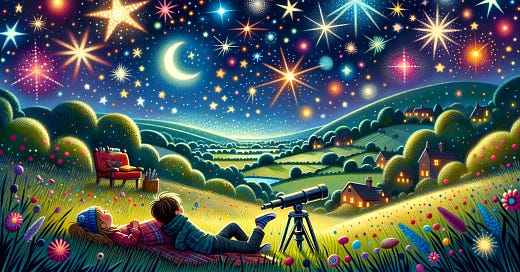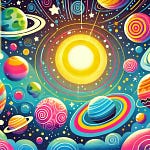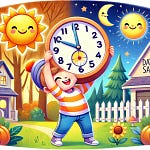Why Do Stars Twinkle at Night?
Have you ever looked up at the night sky and noticed how stars seem to twinkle? They sparkle like tiny diamonds, winking at you from far, far away. But why do they do that? Are stars really twinkling, or is something else going on? Let’s find out!
Hello my friends!
For a quick note, welcome to Tidbits with Titus, a podcast and newsletter where we tackle the big, curious questions kids ask every day in fun, bite-sized ways! I’m Alexander Titus, but I go by Titus. I’m a scientist, adventurer, and a huge fan of making science, technology, and life accessible to all ages. From “How does electricity work?” to “What are taxes?” and even “Why is the sky blue?” I’m here to dive into these wonder-filled questions with engaging stories and simple explanations that spark curiosity and make learning a joy. This effort is all about creating a space where families can learn together, discover the magic of the every day, and find thoughtful ways to explore the world’s big mysteries. Let’s make curiosity a family tradition—one tidbit at a time!
Just so you know, these podcast episodes are all AI-generated using Google’s really cool NotebookLM technology. That means there are some errors in how words are said, but that is part of the fun!
If your little ones have questions that you want help answering, shoot me an email at questions@tidbitswithtitus.com and I’ll see what I can do!
You can subscribe to the newsletter that has this information as well at tidbitswithtitus.com.
Also please share with anyone you think would be interested. The more the merrier!
Cheers,
-Titus
What Are Stars?
First, let’s talk about what stars really are. Stars are giant balls of burning gas, mostly made of hydrogen and helium. They’re like huge, glowing light bulbs in space! The closest star to us is the Sun, which is why it looks so big and bright. All the other stars are much farther away, so they look tiny.
Even though stars are far away, they shine brightly because they’re incredibly hot. Some stars are even hotter than the Sun, while others are cooler. Stars come in different colors too—red, orange, yellow, white, and blue. These colors tell us how hot a star is. Blue stars are the hottest, and red stars are the coolest.
Do Stars Really Twinkle?
Now here’s a surprise: Stars don’t actually twinkle! When you see a star twinkling in the sky, it’s not the star itself that’s flickering. The twinkling is caused by something much closer to us: the Earth’s atmosphere.
What Is the Atmosphere?
The atmosphere is a layer of air that surrounds the Earth. It’s made up of different gases like oxygen and nitrogen. This layer of air is very important because it gives us the air we breathe and protects us from the Sun’s harmful rays.
But the atmosphere isn’t perfectly still. It’s always moving because of wind, heat, and temperature changes. This movement is what makes stars seem to twinkle.
How the Atmosphere Makes Stars Twinkle
When light from a star travels through space, it moves in a straight line. But when it reaches the Earth’s atmosphere, things get a little bumpy. The moving air in the atmosphere bends the light in different directions. This bending of light is called refraction.
As the light bends, it makes the star look like it’s shifting and flickering. Sometimes the light becomes a little brighter, and sometimes it becomes a little dimmer. This is what makes the star look like it’s twinkling.
Why Don’t Planets Twinkle?
You might have noticed that planets like Venus, Jupiter, and Mars don’t twinkle as much as stars. Why is that? It’s because planets are much closer to Earth than stars are. When we look at a planet, we’re actually seeing light coming from a larger area, so the atmosphere doesn’t bend the light as much. This makes planets look steady and bright, not twinkly.
The Best Places to See Stars
Did you know that you can see more stars in some places than others? That’s because light from cities and towns makes it harder to see stars. This is called light pollution. If you go to a place far away from city lights, like a countryside or a mountain, you’ll see a lot more stars. It’s like the whole sky is covered in sparkling jewels!
Fun Facts About Stars
How Many Stars Are There? There are so many stars in the universe that we can’t even count them all. Scientists think there are more stars than grains of sand on all the beaches in the world!
The Biggest Star: The biggest star we know of is called UY Scuti. It’s so huge that it could fit over 1,700 Suns inside it!
The Closest Star: After the Sun, the closest star to Earth is called Proxima Centauri. It’s still so far away that it would take over four years for light to travel from Proxima Centauri to us.
Shooting Stars: Shooting stars aren’t really stars at all! They’re tiny bits of rock or dust burning up in Earth’s atmosphere.
How to See Stars Better
Want to see stars more clearly? Here are some tips:
Find a Dark Spot: Go somewhere away from city lights.
Use a Telescope: A telescope can help you see stars, planets, and even galaxies up close.
Check the Weather: Stars are easiest to see on a clear night with no clouds.
Know the Moon Phases: A bright, full moon can make it harder to see stars, so try stargazing when the moon is smaller.
Why Do We Love Stars?
Stars are special because they remind us how big and amazing the universe is. They’ve inspired people to tell stories, write songs, and make wishes for thousands of years. Some people even use the stars to find their way, like sailors did long ago.
The next time you look up at the twinkling stars, remember that they’re not really twinkling. It’s just the atmosphere playing tricks on your eyes. But that doesn’t make them any less magical. Stars are like little reminders that the universe is full of wonders waiting to be explored.
So grab a blanket, find a dark spot, and look up. The stars are ready to put on their twinkling show just for you!














Share this post